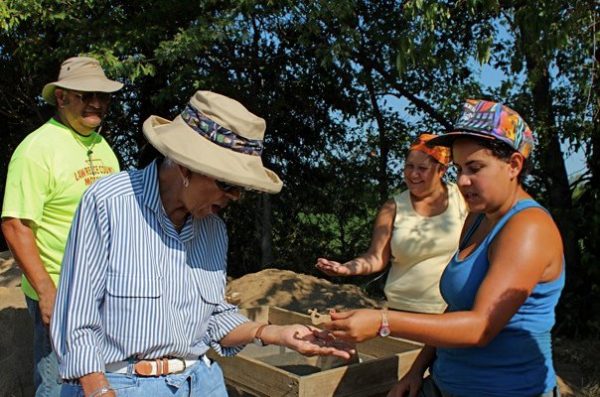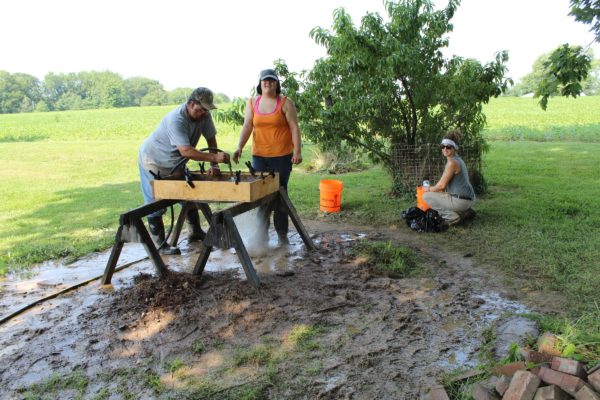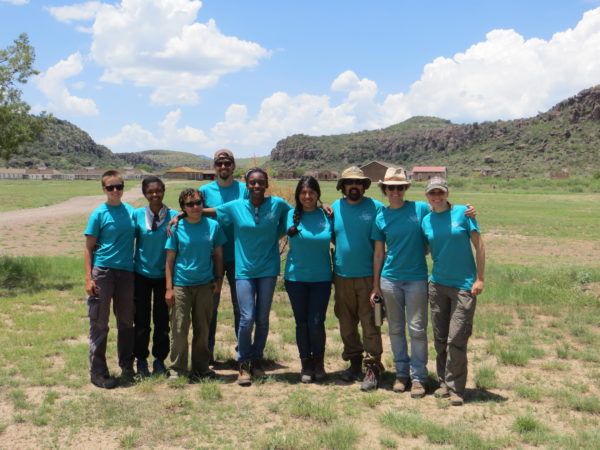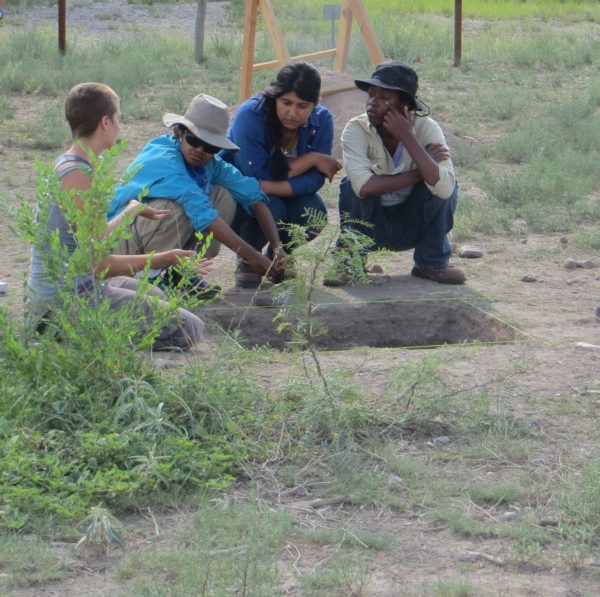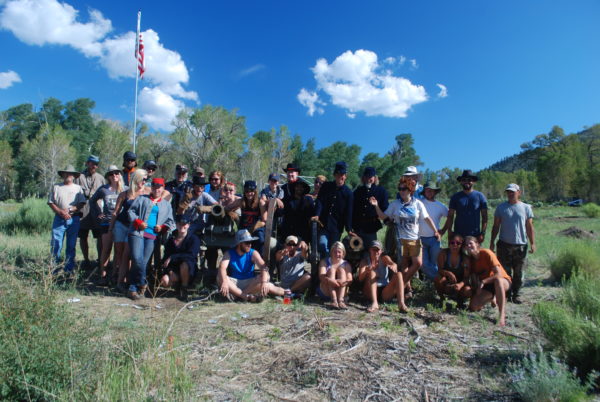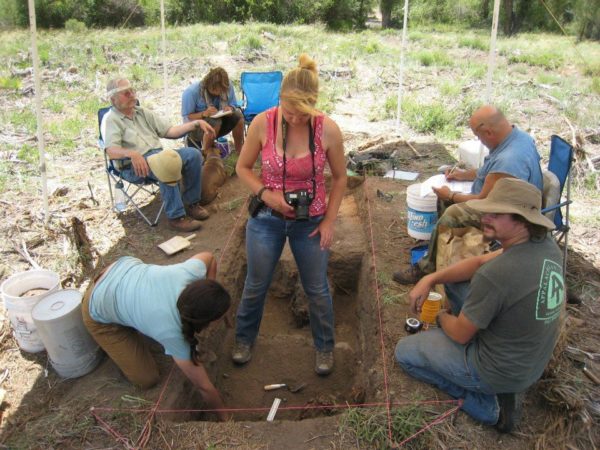Gender and Minority Affairs Committee
Striving Towards Diversity
The members of the Gender and Minority Affairs Committee seek diversity so that the membership of the Society for Historical Archaeology mirrors that of our population in general. We seek diversity as a step towards social justice and an anti-racist, nonsexist, and equal organization. A diverse SHA is only possible if we address structural issues, such as unequal access to education, professional opportunities, healthcare, transportation, and childcare — those issues that continue to maintain SHA’s membership and officers as predominately white, male, heterosexual, and middle class. The mission of seeking diversity involves all historical archaeologists and should be on our collective radars as we work to see our discipline and organization grow and become more socially relevant.

“Offering Semaa,” Fort St. Joseph Archaeological Project, Photo by Katelyn Hillmeyer
Mission
The Gender and Minority Affairs Committee was established as a means to ensure that issues relevant to under-represented members of the Society are given all due consideration in Society deliberations. The Committee strives to foster the growth of a diverse organization and work toward equity across gender, ethnic, physical characteristics and abilities, and class lines.
Goals of the GMAC
- We bring gender and minority issues to the attention of the board and the membership of the Society. We recommend to the board actions and policies, and we develop relevant programs that address those issues.
- We prepare and submit through the chair a report of our activities at the annual and mid-year board meetings and the annual business meeting. We include in the committee’s year-end report a review of the committee’s objectives, accomplishments of the past year, revised objectives, and an assessment of long-range goals.
- We develop specific short- and long-term objectives to further society goals. We implement activities to achieve the long-range goals of the society, as determined by the Board of Directors.
Long- and Short-Term Plans for the GMAC
- Coordinate diversity/anti-racism training for members of the SHA Board and target SHA committee members;
- Work with the Ethics Committee to prepare a statement on gender equity, anti-racism, and GLBT inclusivity;
- Develop a Field School Scholarship for under-represented undergraduate students;
- Further developing the Mentoring Program to enroll, graduate and employ under-represented SHA members and increase and continue membership to the Society, with particular attention to students and junior professional members of the SHA;
- Prepare surveys for assessment of the SHA to measure growth in terms of under-represented groups; prepare surveys for assessment of the Mentoring Program and future GMAC programs;
- Continue to document the history of the GMAC;
- Create a GMAC presence on the SHA website;
- Increase membership and participation in the GMAC Student Subcommittee;
- Organize annual GMAC sponsored forums;
- Establish liaisons with SHA committees and professional organizations; and
- Continue to discuss and address problems related to childcare at SHA meetings.
GMAC Conference Events
The 2016 GMAC Diversity Excursion
Organized by the SHA Gender and Minority Affairs Committee in collaboration with the Director of Alexandria Archaeology
The 2016 GMAC Diversity Excursion will focus on African American heritage. Buses will leave the Omni at 9 am, and participants will begin the day with a 9:30 am tour of Cedar Hill, a National Historic Site and the home of the famous abolitionist Frederick Douglass.
From there, participants will be taken to the U Street Historic District in D.C. where they can choose to have lunch at a number of restaurants that celebrate African American heritage. Eatonville is Andy Shallal’s Zora Neale Hurston-inspired restaurant. Close by sits Busboys and Poets, a restaurant named in honor of Langston Hughes. Also nearby is Ben’s Chili Bowl, which was founded in 1958 by a Trinidadian-born immigrant who studied at Howard University. During the 1968 riots following the assassination of Martin Luther King, Jr., black activist Stokely Carmichael asked Ben to keep his restaurant open. After obtaining permission to stay open past the curfew, the restaurant fed both the police and firemen, and black activists. In the 1950s, Washington, D.C. was officially segregated and U Street was known as “Black Broadway”. Famous artists such as Duke Ellington, Miles Davis, and Nat King Cole performed in clubs along the U Street corridor.
After lunch, the tour will take participants to Alexandria, Virginia. The city has worked for decades to preserve, interpret, and commemorate the city’s African American history. Participants will visit the Contraband and Freedmen’s Cemetery Memorial where more than 1700 African Americans were laid to rest, many of whom were refugees fleeing to the Union-occupied town in search of freedom and opportunity during and after the Civil War. Archaeologists identified more than 600 grave locations on this site, which are now preserved and marked as the result of a federal project. Other stops on the tour highlight two antebellum city businesses involved in captivity and enslavement. At the Bruin Slave Jail, tour leaders will discuss the City of Alexandria’s Archaeological Protection Code and illustrate how this local ordinance has led to archaeological excavations that not only provide insight into the past but also encourage developers to integrate history and archaeology into their site plans. Participants will have the opportunity to view a stature of the Edmonson sisters, who were held at the Bruin site and whose story was featured in Harriet Beecher Stowe’s Uncle Tom’s Cabin which played a significant role in the abolitionist movement. The stop at the Freedom House Museum, the location of the Franklin and Armfield Slave Pen, features exhibits that portray the horrors of the trade of enslaved individuals from the Middle Atlantic region to the cotton plantations of the Deep South. If inclement weather prevents visits to some of the outdoor venues, the tour will proceed to the Alexandria Black History Museum as an alternative. Dress for winter weather, as much of this tour is outside.
The tour can accommodate a maximum of 40 participants.
Tour Time: 8:30 a.m. – 5:30 p.m.
Maximum number of participants: 40
Cost per person: $35.00 (Includes transportation and tour fees. Lunch at your own expense.)
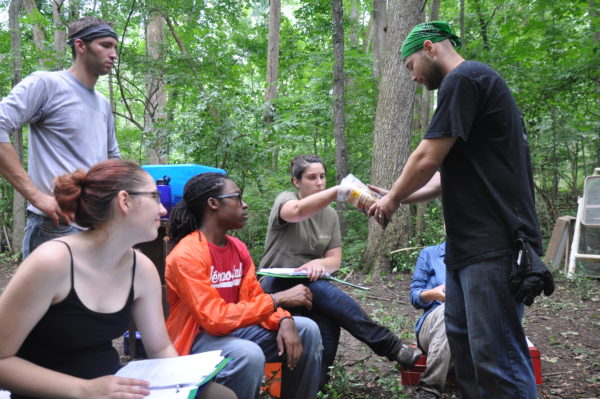 Photo by Katelyn Hillmeyer
Photo by Katelyn Hillmeyer
The activity that the students of the Fort St. Joseph Archaeological project are taking part in is “offering Semaa” (tobacco in Anishnaabemowin). The students are being led by fellow student Seth Allard who was sharing part of his Native American heritage. The essential condition for this action is receiving something significant and reciprocating with a gift of tobacco. Tobacco is a very important item for Ojibwa, and to offer tobacco when receiving a gift is to let the spirit of what you have taken know that you do not accept the gift lightly, but with gratefulness and an understanding that the gift is to be used accordingly and not wasted. We took plants, altered earth, and also gained knowledge through the data collected and at the same time altered the environment of the forest. We then acknowledged both the sacrifice of the plant and animal life we disturbed, as well as receipt of necessary data, which was then used to help us on our path of greater understanding. We were sacrificed for, and taught, by the site of Fort St. Joseph – in response, we showed our gratefulness and humility, promising our use of these gifts in a responsible manner.
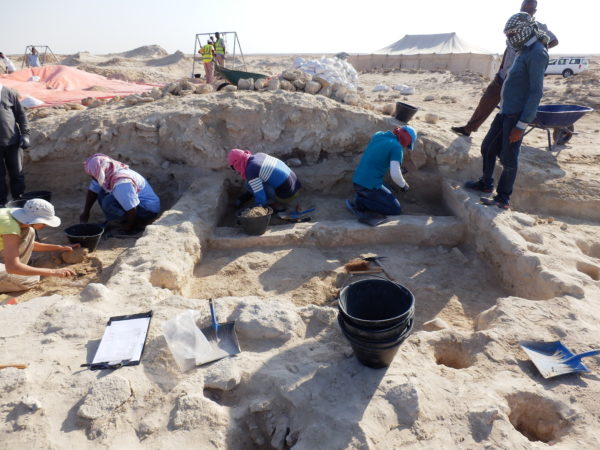
Al Zubarah – Historical Archaeology and International Diversity in Qatar
Photo by Alasdair Brooks
Al Zubarah is the only UNESCO World Heritage Site in the Persian Gulf State of Qatar, and is the country’s most important archaeological site. It is centered on an 18th- and 19th-century pearl-trading town that was a center of intercontinental trade and one of the very first of the independent Arab pearl-trading towns that were the origins of many of the modern Gulf urban centers. Unlike cities like Doha and Dubai, however, Al Zubarah was abandoned at the end of the 19th century, and its ruins offer an important opportunity to study the origins of modern Gulf cities and states.
Every year since 2009, a University of Copenhagen team, working in collaboration with the Qatar Museums Authority, has been undertaking fieldwork at the site. The photograph shows archaeologist Sabrina Salmon excavating date presses in the center of the 18th-century souq, or market along with some of the field work crew. Here we have a Belgian working for a Danish University alongside project-trained Eritrean and Bangladeshi workmen on a field project in Qatar – providing an excellent symbol of the multinational diversity that lies at the heart of our global discipline.
The Nevis Historical Landscape Legacy Project
2025 Winner – Marco Meniketti, San Jose State University


The Nevis Historical Landscape Legacy Project has been serving diverse and traditionally underserved communities of students since 2007. The field school provides a culturally immersive experience on the Caribbean island of Nevis in partnership with the Nevis Historical and Conservation Society. The overarching research theme has been the historical landscape of Nevis, with emphasis on reconstructing the lives of laborers in bondage on sugar plantations during the 17th and 18th centuries. We stress the importance of working with and being sensitive to the descendant community whose heritage we are privileged to study. The field school has annually conducted excavations at sugar factories and estate houses, and investigated three enslaved Africans villages. However, with climate change and storm surge threatening coastal sites, we also devoted time of the last two schools to documenting prehistoric sites eroding into the sea.
Diversity, Equity, and Inclusion are core principles of the field school experience. We seek to increase gender and minority representation, participation from the LGBTQ community, and older second career students and disabled veterans. To diversify the archaeological profession of the future we foster a broad spectrum of students in the present. The majority over the years have been first generation students who had never considered careers in archaeology previously.
The Historic Archaeology of Lawrence County Project Field School
Collaborative Public Archaeology in Lawrence County, Illinois
2014 1st Place Winner – Annelise E. Morris, University of California, Berkeley
This photo was taken at the HALC field site in July 2012. In this photo, co-PI Annelise Morris discusses an artifact with Jan Morris-Brinkman, Russell Morris, and Margaret Morris-Harris. Mrs. Harris (pictured in front) is the great-granddaugher of the site’s founders, Mason and Patience Morris. In this photo, she is sharing with us some of her eories of Martha and Evaline Morris, her great-aunts who ran the farmstead from 1876 until 1923.
This photo was taken at the HALC site in July 2013. In it. Russell Morris, great-great-grandson of Mason and Patience Morris runs the water while he and Gloria Keng, a field student, examine the findings. Alexa Hall, another field student, can be seen taking paleoethnobotanical samples in the background. Russell is one of our most dedicated volunteers, and our project wouldn’t have been possible without his help and knowledge. Gloria has now graduated from US Berkeley, and is assisting with the zooarchaeological analysis of materials from the HALC site.
The Historic Archaeology of Lawrence County project is a collaborative public archaeology project that endeavors to foster diversity in its crew, its collaborators, and in its pursuit of diverse and inclusive ways of knowing the past. As the co-PI of the project, I see diversity as a person’s unique way of knowing, understanding and empathizing with marginalization in our world. I also see diverse ways of knowing the world as an essential component of any archaeological endeavor that seeks to understand our society and its structures in inequality. As an archaeologist and anthropologist, I believe that our discipline has much to offer society in terms of engagements with science, anthropology and philosophy, and only be creating open, collaborative research processes can we fully realize our potential contributions to the world around us.
Our work on the HALC project explores the documentary, oral-historical, and archaeological histories of a group of farmsteads belonging to African-Americans in the 19th century. As a public archaeology project, we endeavor to bring together a diverse group of people, in the hopes that our shared love of history and material culture will create an opportunity to share the ways we understand the past with each other. As such, our crew is made up of community volunteers, descendants, stakeholders, local historians, avocational archaeologists and undergraduate field students. In the interest of making archaeology accessible and relevant to the publics, excavations are open to anyone in the community who is interested in the history, in volunteering, or just in visiting to see what archaeology is all about. Our past two field seasons (July 2012 and July 2013), we were successful in engaging with a wide range of people over the shared experience of field work; and the photos that I’ve chosen from our field school represent a moment in these collaborations.
Volunteers from the community included a wide variety of people, with different interests about the site and what we are learning. Descendants and stakeholders from the African-American community are the largest group of volunteers, usually with questions that center on understanding more aspects of the day-to-day lives of our ancestors. Local historians often are interested to learn more about the African-American pioneer experience, something that isn’t necessarily well represented in the written histories. A local group of avocational archaeologists also volunteered at the site, and they were curious about how our methods as historical archaeologists were different from theirs as people who mostly worked iwht prehistoric remains. Their group also shared their knowledge about the other archaeological sites in the area. Our undergraduates came to the site to learn archaeological skills and practice, but were particularly drawn to the HALC project because of the public and ethnographic aspectsof the project. Not only did the undergraduate students learn archaeological methodology, but during excavations they were paired working with community volunteers, and were able to also learn from the local historians and descendants about their research and remembrances about the past. It is my hope that this diverse group of people mutually benefited from these archaeological experiences.
Edgefield, South Carolina Pottery Communities Field School,
The Pottersville Site, Edgefield County, South Carolina
2014 2nd Place Winners – Jamie Arjona, Tatiana Niculescu, Christopher Fennell, University of Illinois at Urbana-Champaign
This field school focused on investigations at the “Pottersville” site within the area of the “Old Edgefield Pottery District” and provided training in the techniques of excavation, mapping, artifact classification and contextual interpretation. Students and volunteers worked in supervised teams, learned to function as members of a field crew, with skills necessary for becoming professional archaeologists. Evening lectures by project staff, visiting archaeologists, and historians focused on providing background on how field data were used to answer archaeological and historical research questions. The field school was accompanied by a speaker series entitled, “Cultural Creativity, History & Heritage in Edgefield.” With eight events sponsored in part by the Edgefield County Historical Society, with funding support by the South Carolina Humanities Council, we explored the remarkable accomplishments of African Americans, European Americans, and Native Americans across time in the surrounding region.
The first innovation and development of alkaline-glazed stoneware pottery in America occurred in the Edgefield District of South Carolina in the early 1800s. It remains an enduring mystery as to how these new ceramic methods were developed in that place and time, and how the techniques of clay choice, temper, and glaze developed over the following century. These potteries employed enslaved and free African-American laborers in the 19th century, and the stoneware forms also show evidence of likely African cultural influence on stylistic designs. Edgefield potteries thus present fascinating research questions of understanding technological innovations and investigating the impacts of African cultural knowledge and racial ideologies on a craft specialization during the historic period in America.
Many students from past University of Illinois field schools have gone on to graduate study and professional field-archaeology positions. In preparation for this field school, we worked to recruit applicants from diverse backgrounds from colleges and universities nationwide. We also coordinated a large number of volunteers from the local community who worked with field school supervisors in the surveys and excavations. A collaborative group of approximately 30 scholars, graduate students, undergraduate students and volunteers participated in these field school and speaker series activities.
Fort Davis Archaeological Project (FODAAP)
2015 2nd Place Winner – Katrina Eichner and Erin Rodriguez, University of California, Berkeley
Fort Davis Archaeological Project 2014 Field School Team. From left to right, Erin Rodriguez, Naphtalie Jeanty, Ambrose Davila, David Hyde, Carlisia McCord, Elizabeth Flores, Richard Terk, Annie Danis, Katrina Eichner.
Fort Davis Archaeological Project co-director Erin Rodriguez discussing soil development with 2014 students. From left to right, Erin Rodriguez, Naphtalie Jeanty, Elizabeth Flores, Carlisia McCord.
Jeff Davis County Commissioner Larry Francell giving the 2014 Fort Davis Archaeological Project team a tour of Fort Davis National Historic Site. From left to right: David Hyde, Elizabeth Flores, Carlisia McCord, Ambrose Davila, Katrina Eichner, Larry Francell, Richard Terk.
Field School at Fort Massachusetts
2015 2nd Place Winner – Richard Goddard, Adams State University
The Adams State University Field School in Historical Archaeology was begun in 2003 to introduce the ethnically diverse student body to the fields of archaeology and anthropology. ASU is located in an economically depressed, rural, largely Hispanic area and has been designated as an “Hispanic Serving Institution” by the Federal Government.
Our emphasis has always been to include diversity in our students and staff and to focus on research questions of diversity in the past. From 2003 to 2009, our research site was Fort Garland, Colorado, a frontier military post occupied from 1858 to 1883 and characterized by diversity. During the Civil War years, about half of the garrison had Hispanic surnames and in the years after the war it was home to the African American “Buffalo Soldiers.” It was also home to a significant number of women, of various social classes and a number of children. Throughout its history, the fort enjoyed good relations with the local Hispanic and Native American populations.
In 2010, we shifted our research to Fort Massachusetts, the predecessor to Fort Garland. However, our educational and research emphases did not change. In recent years about 25% of our students have been from ASU with the remainder coming from across the U.S. and foreign countries.
The field school accepts 15 to 20 students and runs for 6 weeks usually beginning the last weeks of June and continuing through most of July. It carries 6 academic credits at the undergraduate or graduate level in either anthropology or history. We teach all the basic excavation and data collection techniques as well as a number of recent technological applications (GIS, GPS, LIDAR, GPR) whenever appropriate to the research. Our research has a strong anthropological focus. The site is remote and students camp out at the location. The total cost to students has been $800 for the past several years with the bulk of the costs picked up by private grants and institutional support.
A video that gives a good representation of our activities and the diversity of our staff and students is available on our website at: http://www.adams.edu/academics/fieldschool/.





